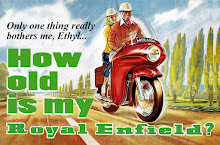 Royal Enfield motorcycles are prized in part because they look like vintage motorcycles from the 1950s. Naturally, the manufacturer has to sell them with modern safety equipment, including rear view mirrors.
Royal Enfield motorcycles are prized in part because they look like vintage motorcycles from the 1950s. Naturally, the manufacturer has to sell them with modern safety equipment, including rear view mirrors.In my opinion, these spoil the classic look. But what does a vintage motorcycle rear view mirror look like, anyway? And when did motorcycles start coming from the factory with mirrors as standard equipment?
 Chris Bartlett responded to my first blog item on this subject by noting that "they appeared on bikes at least as early as 1950 as seen on police Harleys in the 1954 movie The Fast and the Furious. And Jorge Pullin, whose blog My Royal Enfields is always willing to solve mysteries, wrote to this effect:
Chris Bartlett responded to my first blog item on this subject by noting that "they appeared on bikes at least as early as 1950 as seen on police Harleys in the 1954 movie The Fast and the Furious. And Jorge Pullin, whose blog My Royal Enfields is always willing to solve mysteries, wrote to this effect:"Very interesting question about the mirrors! None of the Royal Enfield catalogues I've seen, starting in 1920 all the way to the last Interceptor, ever show a mirror on a bike. They don't list them among accessories either. In line with Chris Bartlett's comment, the Royal Enfield (made) Indian delivered to the New York Police Department in the late 1950s did include mirrors.
"None of the vintage pictures of Enfields I've seen have ever shown mirrors, though many are of too poor a quality to tell for sure about a potentially small element like a mirror. If you look at the pictures of mods and rockers of the 1960s some of the mods' scooters had mirrors (most notably that one in the movie Quadrophenia), but none of the rockers bikes seem to have them.
 "I've found one Honda catalogue from 1965 that shows mirrors. From the mid '70s all of them do.
"I've found one Honda catalogue from 1965 that shows mirrors. From the mid '70s all of them do."It seems attitudes towards motorcycle safety were very relaxed before the 1970s, sort of similar to the attitude some have towards bicycle riding today. Mr. Royal Enfield, Jack Gray, tells a story in his book Motorcycling Through the Thirties about going to race his motorcycle carrying his helmet hanging on the side of the bike on the way to the racetrack. This was because 'wearing a helmet while riding in the street would have been considered pretentious.'
"The bicycle analogy also helps understand why (vintage motorcycles had) horns and no mirrors. Most bicycles have bells or other forms of making noise, but very few have mirrors."
My observation is that Chris and Jorge are correct. I happened to visit the Harley-Davidson Museum in Milwaukee, Wis. over the weekend and found very few rear view mirrors on early motorcycles. The earliest example was on a 1933 sidecar outfit and, here, the mirror was clearly an accessory, along with dual spotlights on the handlebars!
 The next instances of rear view mirrors in the Harley museum come on bikes prepared for the military in World War II and on police motorcycles of the 1950s. In these cases, I suspect the authorities drawing up the bid specifications required that mirrors be included.
The next instances of rear view mirrors in the Harley museum come on bikes prepared for the military in World War II and on police motorcycles of the 1950s. In these cases, I suspect the authorities drawing up the bid specifications required that mirrors be included. It's my belief that some vintage motorcycles did have mirrors, but these rarely show up in advertisements of the time because they cost extra, were strictly an after market accessory or were considered too ugly to display. Jorge pointed out that even today, 2009 Royal Enfield models are shown on the Classic Motorworks web site without mirrors! Of course they come with mirrors, they just look better without them.
It's my belief that some vintage motorcycles did have mirrors, but these rarely show up in advertisements of the time because they cost extra, were strictly an after market accessory or were considered too ugly to display. Jorge pointed out that even today, 2009 Royal Enfield models are shown on the Classic Motorworks web site without mirrors! Of course they come with mirrors, they just look better without them.I have come across pictures of old motorcycles with rear view mirrors, but these were obviously recent color photographs and the mirrors may have been added to get the bikes registered for the modern road.





























I actually think the mirrors ARE attractive!
ReplyDeleteIt appears US Military Police in World War II already had mirrors. See for instance http://www.theliberator.be/indexmenu.html
ReplyDelete